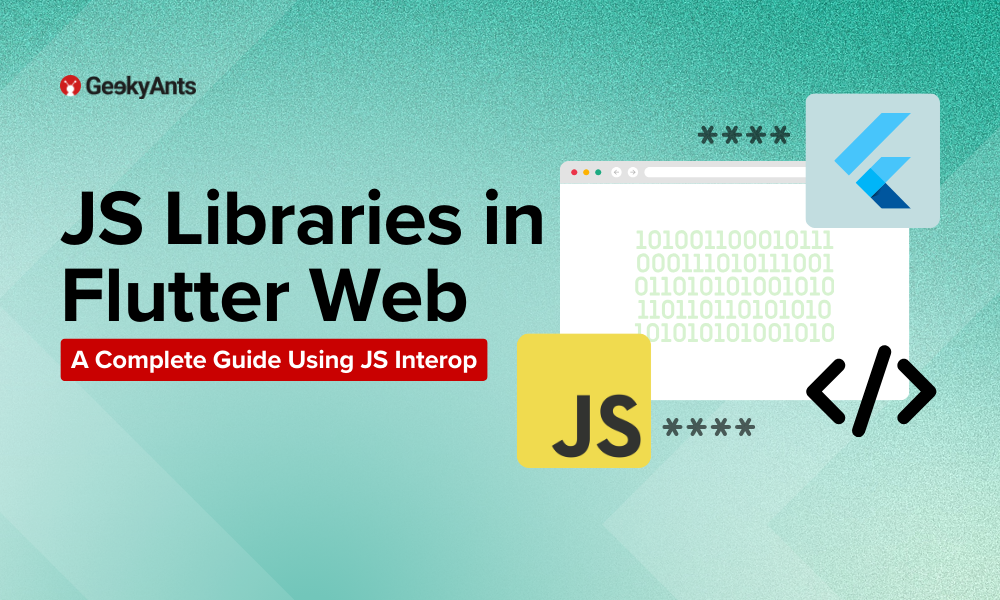Seamlessly Integrating JavaScript Libraries in Flutter Web with JS Interop
 Nikitha N
Nikitha N
Introduction
As Flutter continues to grow in popularity for web development, developers are finding innovative ways to leverage existing JavaScript libraries within their Flutter web applications. One powerful feature that enables this is the JS interop. By using JS Interop, you can seamlessly call JavaScript functions from Dart, allowing you to harness the vast ecosystem of JavaScript packages. In this blog post, we'll explore how to import JavaScript functions into Flutter web, map them to Dart, and use them effectively in your Flutter applications.
What is JS Interop?
JS interop is a feature in Dart that allows you to call JavaScript functions and use JavaScript libraries directly from Dart code. This is particularly useful in Flutter web applications where you might want to use existing JavaScript libraries without having to rewrite them in Dart.
Leverage Existing Libraries: Suppose you're working on a project that requires complex mathematical operations. Instead of writing these complex functions from scratch in Dart, you can use a well established JavaScript library like Math.js. This allows you to benefit from the library's tested and optimized functions, saving you time and ensuring accuracy.
Expand Functionality: Imagine you're developing a Flutter web application that requires real-time data, like a stock market app. Instead of writing a real-time data handling mechanism in Dart, you could use a JavaScript library like Socket.IO which is specifically designed for real-time bidirectional event-based communication.
Efficiency: For instance, if you're assigned with manipulating data in your Flutter web app, instead of writing data manipulation functions from scratch, you could utilize an existing JavaScript library like Lodash. By leveraging the existing code, you save significant development time, allowing you to concentrate on other aspects of your application.
Example: Integrating a JavaScript Library in Flutter Web
Let's use the popular JavaScript library Lodash as an example. Lodash is a utility library that offers various functions for common programming tasks, such as manipulating arrays, objects, and strings.
Step 1: Importing Lodash in index.html
First, we'll import the Lodash library in the index.html file.
<!DOCTYPE html>
<html>
<head>
<title>Flutter Web with JS Interop</title>
<script src="<https://cdn.jsdelivr.net/npm/lodash@4.17.21/lodash.min.js>"></script>
<script>
function shuffleArray(array) {
return _.shuffle(array);
}
</script>
</head>
<body>
<script src="main.dart.js"></script>
</body>
</html>
Step 2: Mapping JavaScript Functions to Dart
Next, we'll map our JavaScript function to Dart using JS interop.
import 'package:js/js.dart';
@JS('shuffleArray')
external List<dynamic> _shuffleArray(List<dynamic> array);
List<dynamic> shuffleArrayJS(List<dynamic> array) {
return _shuffleArray(array);
}
Step 3: Using the JavaScript Function in Flutter
Now we can use the shuffleArrayJS function in our Flutter app just like any other Dart function.
import 'package:flutter/material.dart';
void main() {
runApp(MyApp());
}
class MyApp extends StatelessWidget {
@override
Widget build(BuildContext context) {
return MaterialApp(
home: Scaffold(
appBar: AppBar(title: Text('JS Interop Example')),
body: Center(
child: ShuffleArrayButton(),
),
),
);
}
}
class ShuffleArrayButton extends StatelessWidget {
@override
Widget build(BuildContext context) {
return ElevatedButton(
onPressed: () {
List<dynamic> array = [1, 2, 3, 4, 5];
List<dynamic> shuffledArray = shuffleArrayJS(array);
print("Shuffled Array: $shuffledArray");
},
child: Text('Shuffle Array'),
);
}
}
Conclusion
Harnessing the power of JavaScript Interoperability (JS interop), you can seamlessly integrate almost any JavaScript library into your Flutter web application. This provides a significant boost to the functionality of your Flutter app, enabling you to tap into the rich and robust ecosystem of existing JavaScript libraries readily available.
The beauty of JS interop lies in its versatility. Whether your project requires the use of a complex, feature-rich library or just a simple utility function, JS interop is your reliable conduit between Dart and JavaScript. It serves as a powerful bridge that makes the interaction between these two languages possible and efficient.
With JS interop, your Flutter web application can benefit from the dynamic capabilities of JavaScript without compromising the benefits Dart brings to your project. It is a valuable tool in your arsenal as a Flutter developer, allowing you to create more interactive, feature-packed applications with less effort.
So, dive in, and explore the myriad possibilities that integrating JavaScript libraries into your Flutter web application via JS interop can bring. Embrace the power and flexibility that this feature offers and take your app development to the next level.
Key Takeaways
JS Interop: A powerful feature in Dart for calling JavaScript functions from Dart code.
Efficiency: Reuse existing JavaScript libraries to save development time.
Flexibility: Expand the capabilities of your Flutter web applications by integrating JavaScript functionalities.
By incorporating JS interop in your Flutter web projects, you can create more dynamic, feature-rich applications with less effort. Happy coding!
Subscribe to my newsletter
Read articles from Nikitha N directly inside your inbox. Subscribe to the newsletter, and don't miss out.
Written by